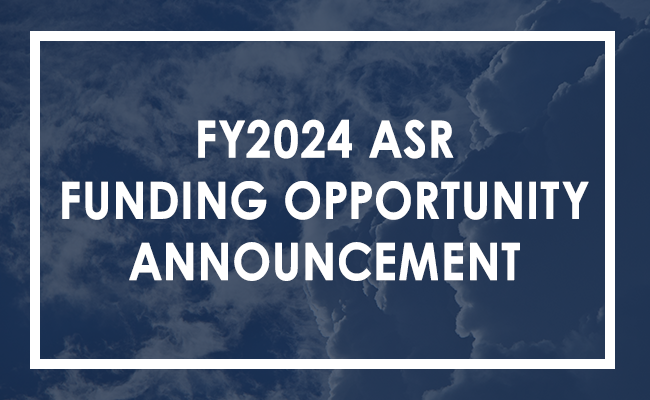DOE awards $15.4 million to improve understanding of atmospheric processes
 The U.S. Department of Energy (DOE) has announced the selection of 20 innovative research projects that will receive funding through its Atmospheric System Research (ASR) program.
The U.S. Department of Energy (DOE) has announced the selection of 20 innovative research projects that will receive funding through its Atmospheric System Research (ASR) program.
Eighty-eight proposals were submitted for funding under DOE Funding Announcement DE-FOA-0003194. The ASR funding opportunity, announced in October 2023, was sponsored by the Office of Biological and Environmental Research (BER) within the DOE Office of Science. The 20 ASR-recommended projects will share cumulative funding of $15.4 million over the next three to five years.
“We want to thank everyone who took the time and did the hard work to submit proposals; it is exciting to support so many new projects,” says ASR Program Manager Jeff Stehr. “The quality of these research proposals was excellent. It was a very competitive review process, and we’re excited about the atmospheric science to come.”
Stehr also noted that the project awards include four investigators and three institutions new to ASR funding and two early-career scientists. “We are pleased to welcome these new investigators and institutions to the ASR program this year,” he says. “Their contributions will enhance ASR science and drive forward our understanding of atmospheric processes.”
The 20 university-based projects will focus on observational, data analysis, and modeling research that uses observations supported by DOE’s BER program, including the Atmospheric Radiation Measurement (ARM) user facility. Each of the projects addresses one or more of the following:
- Aerosol processes at ARM sites
- Convective cloud processes
- Aerosol and cloud processes from ARM’s Eastern Pacific Cloud Aerosol Precipitation Experiment (EPCAPE)
- Mixed-phase cloud and ice cloud processes
Stehr and ASR Program Manager Shaima Nasiri expressed gratitude to those who contributed to the review process. “We want to thank the 61 members of the scientific community who stepped up to help us review these proposals. Each contributed significant time and expertise throughout the peer-review process.”
Nasiri adds that the new projects expand ASR’s footprint in the research community. “With these awards, DOE welcomes four new principal investigators and three new institutions to ASR,” she says. “It is important that funding opportunities are equitably available to all scientists and from all universities.”
As Fiscal Year 2024 funding awards are finalized, detailed information about principal investigators, project titles, abstracts, and team members will be available on the ASR projects web page.
The 20 principal investigators and their ASR-recommended projects include:
- Christine Chiu, Colorado State University – “Discovering Macro- and Micro-Physical Relations in Precipitation Efficiency and Aerosol Wet Scavenging in Warm Clouds Using ARM Observation-Model Data Cubes and Machine Learning”
- Brenda Dolan, Colorado State University – “New Insights into Precipitation Variability and Cloud Processes Using Polarimetric Radar and Cloud System-Resolving Model Simulations”
- Joseph Galewsky, University of New Mexico – “Probing Aerosol-Cloud Interactions in EPCAPE Using Measurements of Water Vapor Isotopic Composition”
- Christopher Hennigan, University of Maryland, Baltimore County – “Aerosol Acidity Across Seasons: Unveiling Dynamic Shifts in Aerosol-Cloud Processes from Regional and Urban Atmospheres”
- Thijs Heus, Cleveland State University – “Contrasting Shallow and Deep Convection over Bankhead National Forest”
- Adele Igel, University of California, Davis – “Macrophysical and Microphysical Properties and Processes in Arctic Fog”
- Matthew Kumjian, Pennsylvania State University – “Using Machine Learning to Uncover Deep Convective Cloud Processes with TRACER Observations”
- Zachary Lebo, University of Oklahoma – “Linking Convective Environments to Microphysical Processes in Updrafts and Downdrafts Using DOE ARM Data and High-Resolution Modeling”
- Gerald Mace, University of Utah – “Using ARM Data to Explore Processes Associated with Southern Ocean Cloud Feedback Using MARCUS, AWARE, and CAPE-k Data”
- Gregory McFarquhar, University of Oklahoma – “Impacts of Cloud-Aerosol-Meteorology Relations in Mixed-Phase Clouds on Radiative Fluxes Over High Latitudes”
- Mark Miller, Rutgers University – “Connecting Aerosol-Related Cloud Brightness to Turbulence using EPCAPE Measurements”
- Christopher Nowotarski, Texas A&M University – “Determining the Importance of Initiation Mechanism and Background Environment on the Evolution of Deep Convection in Varied Regimes”
- Rachel O’Brien, University of Michigan – “Generalizing Aerosol Mixing State: Synthesis from Observations and Connection to Models”
- Mariko Oue, Stony Brook University – “Investigating Microphysical and Dynamical Processes Controlling Convective Cloud Characteristics and Lifecycle within Different Aerosol and Ambient Environments”
- Pallav Ray, Florida Institute of Technology – “Exploring the Land-Sea Breeze Circulation and its Association with Moist Static Energy Using TWP ARM Observations”
- Kerri Pratt, University of Michigan – “Pristine Southern Ocean Aerosol and Cloud Processes: Coupling Single-Particle Measurements and Modeling during CAPE-k”
- David Romps, University of California, Berkeley – “Influence of Urban Features on the Vertical Development of Cumulus Clouds During TRACER”
- Joel Thornton, University of Washington – “Elucidating the Impacts of Shallow and Deep Convective Cloud Processing on Biogenic VOC-Driven particle formation and growth”
- Wendell Walters, University of South Carolina – “From Precursors to Particles: Evaluating Chemical Formation and Sources of Aerosols in the Eastern North Atlantic”
- Christopher Williams, University of Colorado, Boulder – “Identifying and Reducing Structural Errors in Parameterized Warm Rain Processes using ARM EPCAPE and ENA Observations”
This work was supported by the U.S. Department of Energy’s Office of Science, through the Biological and Environmental Research program as part of the Atmospheric System Research program.

